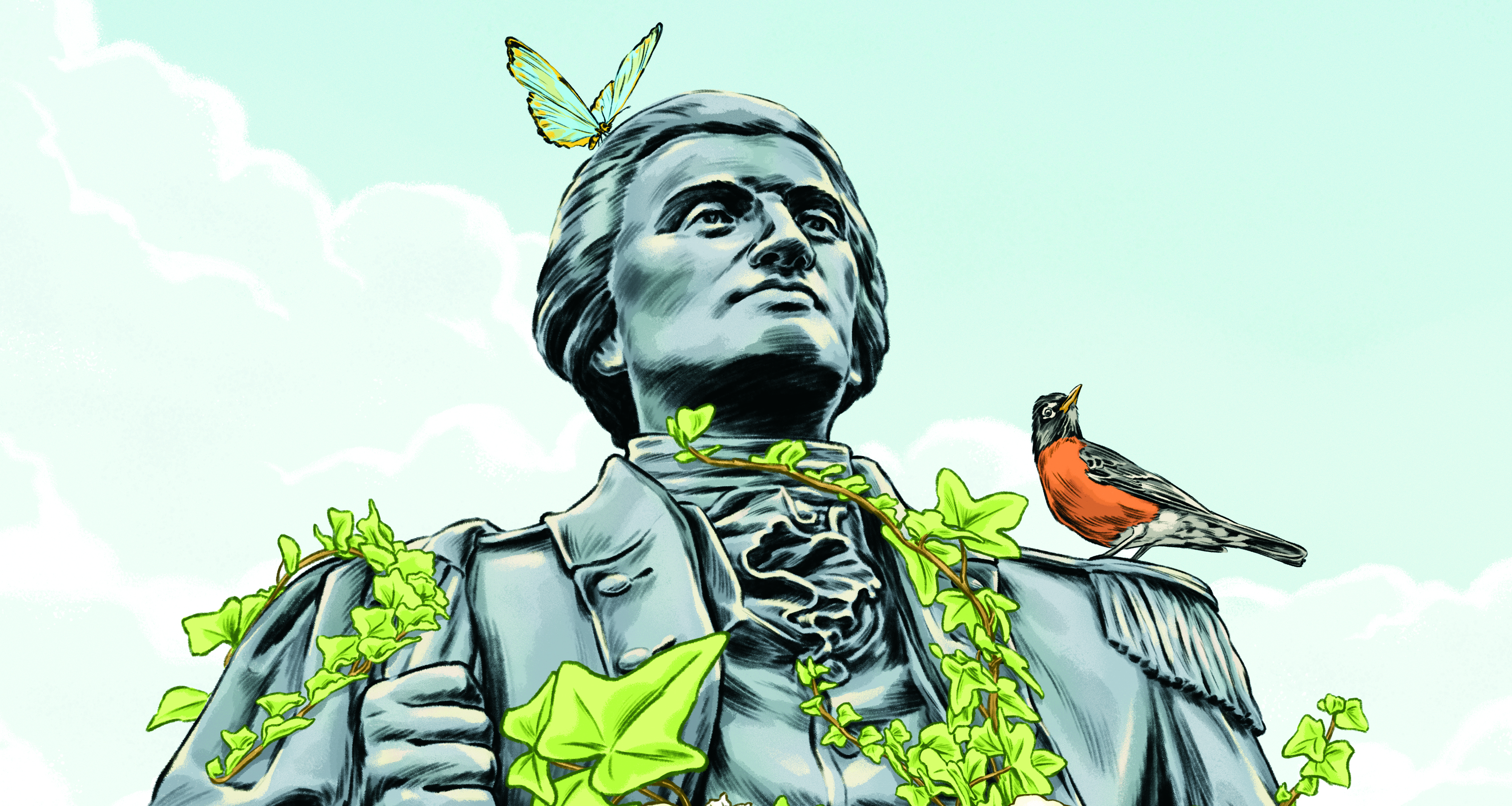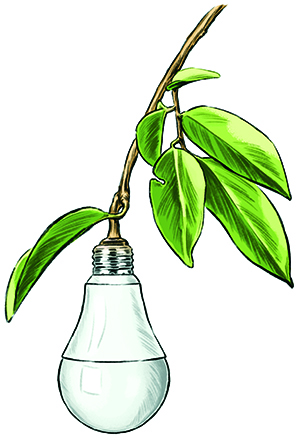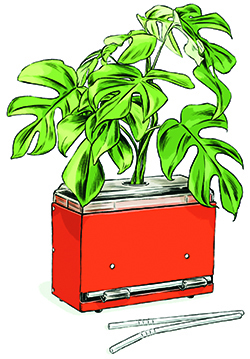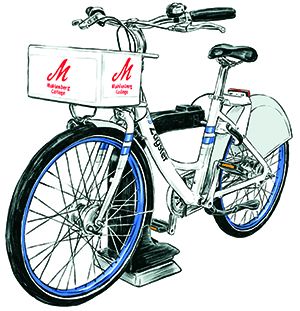Sustainability’s Roots
Dedicated individuals have worked toward “greening” Muhlenberg for more than a decade. Now that the College is committed to a strategy for even greater change, they want everyone to get on board.By: Meghan Kita Wednesday, March 20, 2019 03:07 PM
 Illustrations by Tim Tomkinson
Illustrations by Tim TomkinsonMuhlenberg’s Plant Operations building houses two massive boilers, each about the size of a small RV. Not long ago, they would run from when the weather turned cold (in late September or early October) until it got warm again (usually in April), creating steam that ran through underground pipes to heat campus buildings. The boilers, which replaced their coal-fired predecessors in 1965, burned oil, then natural gas. The workers in charge of maintaining the metal monstrosities had to yell to hear one another.
Now, even in winter, the boilers sit silent, collecting dust. In 2018, the College completed a three-year, $6.5 million project that replaced this centralized steam system with natural-gas-powered boilers in each building. Those are at least 93 percent efficient—the old system was somewhere in the 70s—and the conversion allows the College to monitor each building’s natural gas usage. Every building also has an electricity meter, and nearly every building has a water meter.
“You can have sustainability objectives, like to reduce your carbon footprint, but you have to be able to measure it,” says Professor of Biology Rich Niesenbaum, director of the College’s interdisciplinary program in sustainability studies. “Now, we’re in a place to do that.”
Quiet, behind-the-scenes efforts to increase sustainability at Muhlenberg, such as the gradual silencing of the central steam plant, have been ongoing for at least the past 15 years. The absence of noise hasn’t been intentional; the faculty, staff and students dedicated to change have been busy enacting it, often without much fanfare or publicity. But the architects of these efforts at Muhlenberg—Niesenbaum, Sustainability Coordinator Kalyna Procyk, Chief Business Officer & Treasurer Kent Dyer and the 12 other members of the President’s Committee on Sustainability—are entering a new era, with support from President John I. Williams Jr. And they want everyone to know about it and join them.
This year, for the first time, Muhlenberg earned a Gold certification from the Association for the Advancement of Sustainability in Higher Education (AASHE), the only Lehigh Valley institution to receive that level of recognition at press time. In February, faculty approved a proposal to add a major and revise the existing minor in sustainability studies in response to the rapid growth of this interdisciplinary academic field and increasing student and prospective-student demand. And, last May, President Williams approved a 20-page Sustainability Strategic Plan. Part of that plan involves making sure Muhlenberg’s commitment to sustainability is unmistakable.
 The plan defines sustainability as “meeting the needs of the present without compromising the ability of future generations to meet their own needs.” To meet the present needs of a community like Muhlenberg’s, you have to know what those needs are—all of them. That’s why the President’s Committee on Sustainability includes students, alumni, professors, administrators, plant operations staff, dining services staff, communications staff and housing and residence life staff. The group started by going after what Niesenbaum calls “low-hanging fruit,” things like more efficient lighting and improvements to recycling. As the College saved energy and money and received positive feedback, the committee was empowered and encouraged to do more.
The plan defines sustainability as “meeting the needs of the present without compromising the ability of future generations to meet their own needs.” To meet the present needs of a community like Muhlenberg’s, you have to know what those needs are—all of them. That’s why the President’s Committee on Sustainability includes students, alumni, professors, administrators, plant operations staff, dining services staff, communications staff and housing and residence life staff. The group started by going after what Niesenbaum calls “low-hanging fruit,” things like more efficient lighting and improvements to recycling. As the College saved energy and money and received positive feedback, the committee was empowered and encouraged to do more.
“The sustainability committee has been working very doggedly and very diligently to keep moving things forward,” Procyk says.
When President Williams first met with the group in 2016 and heard of their efforts, he said, “You guys are doing amazing work, but there doesn’t seem to be a well-structured strategy behind what you’re doing,” Niesenbaum recalls. That conversation inspired the creation of the Sustainability Strategic Plan. Its 16 main goals are divided into five categories—Curriculum and Co-Curricular Integration, Buildings and Grounds, Food and Dining, Energy and Climate and Planning and Administration—that provide a useful framework to discuss where the College is now as well as where it plans to go.
Curriculum and Co-Curricular Integration
Muhlenberg’s interdisciplinary minor in environmental studies was redesigned in collaboration with a group of faculty and renamed “sustainability studies” when Niesenbaum became director in 2007. The reason the program needs to be interdisciplinary—with equal focus on the environmental, economic and social factors that must be considered to achieve sustainability—is because “protecting nature without considering the needs of our own species never works,” Niesenbaum says. He gives the example of a hypothetical biological reserve: If it’s created in such a way that it causes the quality of life for the humans living in and around the reserve to decline, it will fail.
Another obstacle to achieving sustainability is guilt paralysis: “Students are taught that these are desperate times as we are confronted with what seem like insurmountable problems, and this can be crippling,” Niesenbaum says. “My approach has been to teach students that they can solve these problems, whether through the action of individuals, through innovation or through policy or social movements.”
 What that looks like depends an individual student’s interest—one might gravitate toward entrepreneurial solutions, another toward political activism and another toward environmental education. But a crucial skill all students in the program learn is how to communicate about sustainability issues in a productive way. Research shows that listening and finding common ground are both necessary to effect positive change.
What that looks like depends an individual student’s interest—one might gravitate toward entrepreneurial solutions, another toward political activism and another toward environmental education. But a crucial skill all students in the program learn is how to communicate about sustainability issues in a productive way. Research shows that listening and finding common ground are both necessary to effect positive change.
“Starting a conversation by calling somebody a climate denier shuts down the conversation immediately,” Niesenbaum says. “How you have that conversation, whether it’s about climate change or social justice issues, is to first listen, to hear how somebody who’s different from you feels about the subject, to get an understanding of conflicting imperatives and to find the areas of overlap in shared values.”
There’s been demand for a major in sustainability studies: nine students, including three currently at Muhlenberg, have self-designed sustainability-related majors, and two more have proposals in the works. Because of this—plus increasing interest from prospective students, and the program’s emphasis on integrative learning—Muhlenberg has responded by creating one. Fifteen academic programs are represented on the list of courses that count towards the major, including options from English, philosophy, anthropology, history and religion. Students will be able to declare sustainability studies as a major this fall.
“The endorsement of a new major in sustainability studies by the Muhlenberg faculty not only puts the College on the cutting edge of sustainability education, but because the new major emphasizes connections among disparate disciplinary perspectives in order to empower students to recognize and solve problems, it also reaffirms our broader commitment to integrative learning and the liberal arts,” Niesenbaum says.
Natalie Warhit ’19, a current self-designed sustainability studies and philosophy double major, says she’s excited for the new program: “It’s similar to the major I made and some of the ones my friends have created as well,” she says. “I feel good that we might have been showing the College that this kind of major is what incoming students want.”
The Sustainability Strategic Plan includes a roadmap to introduce all Muhlenberg students to the tenets of sustainability, regardless of their field of study. Within the next two years, sustainability will become part of first-year student orientation. Starting this semester, instructors of the universally required Foundations for Student Success course are spending at least one class session introducing students to the concept of sustainability.
“Now it’s not just a small group of dedicated students, faculty and staff, but every single student that will have the opportunity to be exposed to the wave of the future in terms of sustainable living and to incorporate sustainable habits and values into their own lives,” Procyk says.
Buildings and Grounds
This category is where the Sustainability Strategic Plan intersects with the Campus Master Plan. Within the next three years, the College intends to break ground on an addition to Seegers Union, a new academic building and a new residential/retail space. The sustainability plan calls for those and all building projects to follow green standards in their design, construction, operation and maintenance, and for byproducts, when possible, to be reused or recycled.
“We call buildings we construct and design here ‘forever buildings,’” says Capital Projects Manager Dave Rabold. “We make sure the architect and the contractor get the details right. That way, what we build lasts, and if it lasts, it’s sustainable.”
Renovating or repurposing existing buildings, when possible, is even more sustainable. Rabold cites the East Hall renovation, which wrapped up five years ago and included efficiency improvements such as new windows and better-insulated walls and ceilings. It was built in 1903, “and now it’s ready for the next 100 years,” Rabold says. More than 80 percent of the waste from that project was recycled.
Director of Plant Operations Jim Bolton tracks the College’s recycling efforts. Last year, Muhlenberg diverted more than 12 tons of scrap metal from landfills. He also coordinates with the College’s recycling and trash companies and speaks to classes on the topic.
“If you corrupt the recycling, it gets thrown out,” Bolton says. Plastic bags, for example, can get stuck in recycling machinery. If a load of recycling clearly contains items that aren’t recyclable, the entire load may be discarded—a little-known reality that he wants to make sure members of the Muhlenberg community understand. “When in doubt, throw it out,” he adds.
Plant operations staffers have also collaborated with students to install a solar hot-water heater on the sustainability-themed Muhlenberg Independent Living Experience (M.I.L.E.) house, the Tree House, and have shown Niesenbaum’s students how to insulate windows.
“The culture in plant operations is to interact with students and faculty, and we recognize their expertise, so they bring a lot to the table,” Niesenbaum says. “At larger institutions, operations departments and offices of campus sustainability are often separated from the academic part of the institutions, but here, we have our students working directly with plant operations leadership and staff. That is what’s really unique at Muhlenberg: the broad stakeholder collaboration when it comes to campus sustainability and sustainability education.”
Food and Dining
More examples of that collaboration can be found in Muhlenberg Dining, which employs three sustainability interns each semester. Warhit began interning there during her sophomore year.
“I’m really interested in the intersectionality between the environmental movement and animal rights,” she says. “I want to educate people on the negative environmental effects of animal agriculture.” And, promoting meatless options is one of the most immediate Food and Dining priorities in the Sustainability Strategic Plan.
Last fall, Warhit worked with her supervisor, Operations Manager Peter Stark, on National Vegan Month and Meatless Monday programming. An event right before finals last semester offered free samples of the Wood Dining Commons’ vegan sweet pea burgers on pumpkin rolls.
“Within 15 minutes, we had gone through 50 to 75 sample portions,” Stark says. “The interns who were coordinating the effort are very passionate about it and were able to encourage people to try new things.”
 Stark’s own passion project is the elimination of single-use plastics. His interest began when he saw the story of Scottish elementary school students who, after cleaning thousands of plastic straws off an uninhabited island, lobbied their village to ban them by the end of 2017. Muhlenberg followed their lead, switching from wrapped plastic straws to dispensers with unwrapped paper straws for the spring 2018 semester. In July, plastic straws made national news—with Seattle, Washington, banning their use and Starbucks announcing a two-year plan to phase them out—and Stark had to scramble for a new supplier due to a shortage of the paper straws he first bought.
Stark’s own passion project is the elimination of single-use plastics. His interest began when he saw the story of Scottish elementary school students who, after cleaning thousands of plastic straws off an uninhabited island, lobbied their village to ban them by the end of 2017. Muhlenberg followed their lead, switching from wrapped plastic straws to dispensers with unwrapped paper straws for the spring 2018 semester. In July, plastic straws made national news—with Seattle, Washington, banning their use and Starbucks announcing a two-year plan to phase them out—and Stark had to scramble for a new supplier due to a shortage of the paper straws he first bought.
Still, he says, “Straws are kind of a symbolic thing for plastics. They’re a small part of a huge problem.” Straws make up just 0.025 percent of the plastic pollution in the ocean. That’s why Muhlenberg Dining introduced ‘Berg to Go containers—reusable clamshells for food—in the Wood Dining Commons in 2013, and why Stark introduced a pilot program to include reusable to-go cups this semester. He hopes to see a reduction in the 30,000 disposable cups (often accompanied by compostable plastic lids) the dining hall goes through monthly.
The biggest sustainability challenge, he says, is finding a local commercial composter that can accept the bulk of Muhlenberg’s food waste. (Coffee grounds from Java Joe and the General’s Quarters have been composted on site since 2014.) Currently, waste is turned into a compostable pulp that is then incinerated for energy.
“Energy generation is better than a landfill,” he says, “but not as good as reusing, reducing or composting of product.”
Energy and Climate
And when it comes to energy use, less is better than more. That’s why the Sustainability Strategic Plan includes efficiency-related goals such as swapping 10 percent of all low-efficiency lighting for LEDs each year (a process that began in 2010) and converting the last eight of the 60+ M.I.L.E. and faculty/staff houses from oil to natural gas (a process that began in 2011).
In 2018, those houses all got digital thermostats that plant operations can monitor from their central usage dashboard. This decision was, in part, a practical one—students leaving for break can no longer shut off their heat entirely, which had caused damage to the homes in the past. But also, students can learn to program the thermostats so they’re using less energy overnight or when they’re out of the house, and the College can collect data on heat use that can help students shape their habits.
“We see the M.I.L.E. houses as a huge opportunity for students to learn how to live more sustainably before they get out into the real world,” says Procyk. “It’s really important to give students the chance to change their own behavior.”
 Students who want to get around more sustainably can use their College ID to ride Lehigh and Northampton Transportation Authority buses for free (new this semester, and also available to faculty and staff) or try the on-campus bike share, launched in partnership with the Allentown Parking Authority in October. Anyone in the community can use the bike share, which runs through the Zagster app and costs $15 annually for students, faculty and staff and $25 annually for everyone else. There are currently docking stations by the Baker Center for the Arts and in downtown Allentown, with more in the works, and the bikes have built-in locks that keep them secure anywhere.
Students who want to get around more sustainably can use their College ID to ride Lehigh and Northampton Transportation Authority buses for free (new this semester, and also available to faculty and staff) or try the on-campus bike share, launched in partnership with the Allentown Parking Authority in October. Anyone in the community can use the bike share, which runs through the Zagster app and costs $15 annually for students, faculty and staff and $25 annually for everyone else. There are currently docking stations by the Baker Center for the Arts and in downtown Allentown, with more in the works, and the bikes have built-in locks that keep them secure anywhere.
“This is an excellent way for the College to facilitate students reducing their personal carbon footprints,” Procyk says. “Instead of driving downtown, driving to the store, they can just grab a bike and go do it. So, they can lower their carbon footprint and engage with the community. Plus, it’s better for your health.”
Planning and Administration
Sustainable decision-making often generates more benefits than just a lower carbon footprint. Efficiency saves money, and some efficiency upgrades are eligible for rebates. For example, the College spent $22,000 to purchase the aforementioned digital thermostats, and $18,000 of that money—82 percent of the up-front cost—came back in rebates from UGI Utilities.
As part of the Sustainability Strategic Plan, Dyer set up a Green Revolving Fund that allows the College to invest in energy savings projects and then put the money saved on utilities in the fund to repay the investment.
“We’re going for the easier projects at first, with quicker paybacks,” Dyer says. “When the utility bills go down, that money goes back into the fund until the investment has been repaid. And then after that, we’ll get into some of the longer-term projects that may not be as quick to pay off.” Some of those projects include replacing aging mechanical systems and upgrading cooling towers.
“That’s the sustainability of sustainability,” Niesenbaum says of the fund. “That’s how you keep it going.”
Students have been active in requesting that the College consider sustainability when deciding how its endowment is invested. Of the $270 million endowment, $150 million is in equity, and $10 million of that is currently invested in two Environmental, Social and Governance (ESG) Funds: one that includes fossil fuel companies and one that does not. The Sustainability Strategic Plan keeps the door open on this ongoing conversation, with a plan in the next two years to continue exploring investment options “that are more consistent with sustainability objectives.”
“Millennials have been surveyed, and the majority of them are interested in, when they get things like 401Ks and are able to invest money, looking at doing it in a socially just, sustainable, meaningful way,” Niesenbaum says. “So that’s an opportunity for the College.”
And with all this opportunity comes another: to shout from the green and/or solar-panel-covered rooftops exactly what the College is doing in terms of sustainability. The Sustainability Strategic Plan calls for signage highlighting sustainable improvements, incorporation of sustainability into campus tours and updated information on the College website and in College publications—which starts with this story.
“We have made sustainability a priority at Muhlenberg, but we need to outwardly own it, both in the ways that we communicate about our institution and in our actions,” Niesenbaum says.
